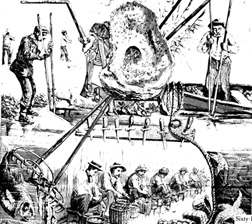
The Life and Times of Chesapeake Oysters
Our beloved, beleaguered bivalve may be the last best hope to bring back the Bay.
Five years ago, New Bay Times began publishing, dubbing itself the newspaper committed to the Chesapeake.
But over the years, we've come to realize, nobody is more committed to Chesapeake Bay than oysters.
We've always revered oysters for their good taste. Now we know oysters are far more than tasty.
"Because they play such a key role in the ecosystem, oysters are known by ecologists as keystone species," says Bill Goldsborough, senior scientist at the Chesapeake Bay Foundation and board member of the Oyster Recovery Partnership.
The very water of the Bay is purified by oysters as they feed and filter microscopic algae from the water. In the 19th century, oysters filtered the entire Bay's waters in seven days. That job takes today's oysters a whole year. Even so, in prime summer condition, an adult oyster filters 50 gallons of water a day. In addition, oysters' reef communities are home to many other plants and animals.
So efficient are oysters that their recovery is viewed by many as the only sure-fire way to clean up the Bay.
That's why, in celebrating five years of New Bay Times, we could think of no better recipient of our birthday gift than that beloved, beleaguered bivalve.
Our birthday gift to the Bay is to add as many dollars as we're able to oyster recovery. We're donating the money raised at our Bivalve Birthday Bash to the Oyster Recovery Partnership, a nonprofit co-venture of watermen, scientists and environmentalists. We hope you'll join us to celebrate and swell the pot.
Each $1,000 we raise will buy 10 seeded bags of 100 oysters each. These New Bay Times oysters will be ours and yours. They'll belong to all 40,000 weekly readers of New Bay Times.
Read along in the future - and perhaps join us - as we prepare the seed bags for our oysters. Learn how we plant those oysters in the South and Severn Rivers. Follow our oysters from spat to maturity. Some day next summer we will wish them well as they graduate from protected sanctuaries to mature life as part of an oyster reef. For millennia, oysters have been part of our culture and heritage, as this New Bay Times special report shows.
5,500 BC: Shells of Ancient History
Chesapeake Bay oysters have been enjoyed at least this long, witness oyster shell mounds at the encampments of Native Marylanders as far back as the Golden Age of Greece.
As we go to press, news comes of a Native American village newly unearthed at London Town House and Garden in Edgewater. Tipping off archaeologists was a bed of oysters 10 inches thick. Reading the evidence of pottery shards, Anne Arundel County archaeologist Al Luckenbach dates the settlement to Woodland Indians, who flourished from 1200 a.d. to the European settlement.
Chesapeake is derived from a Native American word meaning "the great shellfish Bay."

1607: A Very Goodly Bay
English explorer Captain John Smith sees the Bay and pronounces it good.
1650: Humans Take Their Toll
Picture a plate-sized roasted oyster wading in home-churned butter. This was life in 17th century Maryland, when oysters were huge. Even then, the appetites of colonists took a measurable toll on oysters.
Archaeologist Henry Michael Miller found that intensity of harvesting led to smaller oysters. In the late 1600s, the population of St. Mary's City peaked at about 250 people. From 1645 to 1695, just 50 years, the oysters that Miller uncovered declined in size by 50 percent.
When the capital moved to Annapolis in 1695, so did many of the people. The size of St. Mary's oysters increased.
Miller dug through old rubbish pits, cellars and even toilets while working on his doctorate in the 1980s.
In Anne Arundel County, research by Jim Gibb and Anson Hines has showed that oysters were harvested at five to six years of age - about twice as old as those taken from the Chesapeake today. Their research at the Smithsonian Pier site showed, too, that people didn't worry about oyster seasons. From the condition of the shells, over half the oysters seem to have been harvested in warmer months.
Overall, Gibb and Anson concluded from oysters that the late 17th century Chesapeake was a stable, mature marine environment. These waters "allowed the oysters to proliferate and provide a reliable source of food for the area's human inhabitants," they wrote.
It wouldn't stay that way.

Early 1800s: Others Eye Our Bounty
Already, New England and New York have nearly harvested their way through their oyster beds. Commercial oystering turns to Chesapeake Bay, with visiting oystermen stimulating local competition. Within a decade, Maryland becomes the East Coast's largest oyster purveyor.
1808: That Damnable Dredge Appears
New Englanders introduce the dredge to Chesapeake oystering. A dredge is a net basket supported on a metal frame dragged by a long rope behind a boat across the Bay floor. The dredge bar is often toothed to dislodge oysters, which are set into their reefs like stone.
The efficiency of the dredge was formidable. By 1820, dredging was forbidden by the Maryland legislature. So were competing watermen from neighboring states.
1850: A City Built on Oysters
It may be a glitzy string of shops and restaurants now, but Baltimore's Inner Harbor was once a cannery row - a strip of packing plants where oysters were shucked, steamed and canned. In the 1800s, the demand for canned oysters made Baltimore the canning center of the nation.
As Chesapeake oysters filled the gap left by declining New England oysters,
Baltimore rose as an industrial power. Soon cluttering the waterfront were
houses where men, women and children shucked and pickled oysters. Two technological
leaps made Baltimore th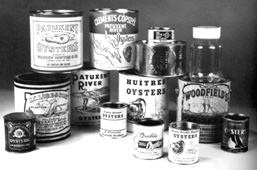 e world's largest
oyster supplier.
e world's largest
oyster supplier.
In 1830, the B&O railroad opened, enabling Baltimore to supply the expanding Midwest with oysters. In the 1840s, the canning process was developed. Previously, oysters had been sold raw or pickled. But now oysters could be sterilized with heat and then sealed in tin cans. The new method made the product safe, tasty and portable.
Wherever the iron horse went, populations and prosperity usually followed. During the Gold Rush, for instance, Baltimore was the Pacific Coast's primary oyster supplier.
When the Civil War struck, the oyster market crashed. Watermen made more money smuggling than oyster farming. But after the War, as the nation enjoyed an economic boom and consumers could again ask for and receive their oysters, the industry rebounded.
So great was the demand, that Oyster City - as Baltimore was called then - was producing five million bushels of oysters annually, employing thousands of freed slaves and immigrants.
But by the end of the century, Baltimore's canneries began to close. High volume sales had encouraged high volume farming, and the Chesapeake's oyster population was falling. Once again the demand for oysters had overwhelmed the supply.
1865: Oyster Pirates on the Prowl
Dredging is again legalized, opening the way to the great oyster boom
of the 1880s. Meanwhile, oystering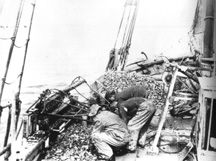 enters
what author Paula Johnson calls an "era of general mayhem" as
oyster pirates pursued by oyster police indulged in every kind of lawlessness,
including shanghaied crews "paid off by the boom."
enters
what author Paula Johnson calls an "era of general mayhem" as
oyster pirates pursued by oyster police indulged in every kind of lawlessness,
including shanghaied crews "paid off by the boom."
Johnson quotes a Fish and Wildlife inspector who, in 1887, described "a general scramble carried on in 700 boats by 5,600 daring and unscrupulous men, who regard neither the laws of God nor man."
The 700-vessel oyster fleet was made up of bugeyes, pungies, schooners and sloops.
1880: Abundance Unimagined
In 1885, Chesapeake Bay's oyster harvest climbed to its highest point as 15 million bushels of oysters were taken from Bay waters. In this heyday, Chesapeake oysters traveled as far inland as Chicago and St. Louis, and many a Midwesterner grew up with a taste for raw oysters.
To satisfy the appetites of half the nation, the Chesapeake oystering industry boomed. One of the oyster houses springing up to meet that demand was J.C. Lore & Sons in Solomons. In Lore's history you can follow the rising and falling curve of oyster fortunes. Its story is well preserved at Calvert Marine Museum at Solomons Island in the very building where oysters were shucked and shipped for nearly a century.
Technology kept pace with demand. Charles L. Marsh, a blacksmith in Solomons, patented mechanical tongs to enable watermen to reach deep into virgin oyster beds.
"The difference in catch between my tongs and the old tongs is perfectly astonishing," Marsh wrote in 1890. Patent tongs could produce a catch of 30 to 100 bushels a day while an oysterman working by hand with shaft tongs could bring up only eight to 25 bushels. The rake-like tongs were raised by a hand crank and later a motorized winch.
Decorative arts kept pace, too: the best families ate their oysters from oyster plates, molded to the shape of six oysters and often decorated to resemble the real thing - even to the pea crab.
1890s: Skipjacks Signal Sinking Stores
As the frenzy continued, new tools reached farther to keep up the harvest. Thus was developed the skipjack to give watermen smaller and cheaper boats able to work both shallow and deep water with a small crew of three or four men. Dredging was the only purpose of these two-sail, single-masted, V-bottomed boats.
Today, perhaps three dozen remain in working condition, and as late as 1993, 14 skipjacks dredged for oysters, taking advantage of the 1865 law allowing dredges to be pulled only by boats under sail.
Today many of the remaining skipjacks berth at the neighboring Eastern Shore ports of St. Michaels and Tilghman Island. You can see several at Chesapeake Bay Maritime Museum, including the Rosie Parks, dredging license 19, built in 1955. At Tilghman wharves, where skipjacks tie up among the other workboats, you can go out on the Bay on a skipjack cruise.
At NBT's Bivalve Birthday Bash, you can bid on a cruise for 20 aboard Chesapeake Bay Foundation's skipjack Stanley Norman.
1906: Bay Beds Mapped
Surveyor Charles Yates finds 769 natural oyster bars covering 215,845 Bay acres.
'20s-'50s: More Mechanization
Patent tongs now are run by motorized winches. By the '30s, Chesapeake Bay's oyster fleet switches from sail to gas. But the sailing fleet keeps a special advantage: Only a ship under sail can dredge for oysters.
In 1958, two Calvert countians - William Edward Barrett, a waterman, and T. Rayner Wilson, a blacksmith - adapt the technology of the day, hydraulic power, to tonging for oysters. An oysterman using hydraulic tongs can double the efficiency of a patent tonger - and quadruple the efficiency of a hand tonger.
1942: Seeds of Change
As wild oysters can no longer support human demand, oyster farming begins. Seed is moved from productive reefs to jump-start poorer locations or, in later years, areas ravaged by Dermo or MSX.
1998's natural spawn has been extraordinary, up from about 1,000 spat per bushel to 2,500. A whopping 400,000 bushels of that spat-rich shell will be raised from the Eastern Bay and Choptank River to seed poorer beds this spring, at a cost of half a million dollars.
1950s: Twin Perilous Prowlers
In 1954, a protozoan parasite named Dermo appears in Chesapeake Bay. Nastily suited to the Bay's estuarine environment, it kills every oyster it touches. Dermo can wipe out a bed in three years.
In 1960, Dermo's deadly cousin, MSX moves in from Delaware Bay. It kills oysters very efficiently, wherever it finds waters salty enough for its taste - usually no higher in Chesapeake Bay than the Wye River.
Both diseases stalk Chesapeake Bay, combining with pollution, human population pressures and nearly two centuries of heavy harvests, laying oysters low. Dermo and MSX have caused losses of up to 90 percent. Both appear here to stay.
Today's battle against the diseases is a strategic one, carried out by moving young oysters out of the salty areas where seed sets well but where disease also thrives into less salty northern areas.
Scientists studying the diseases at every level hold out hope of breeding disease-resistant stock with which to reseed ravaged beds. Each new advance in knowledge can be translated to a step in action. For example, knowing that Dermo peaks in June points the way to better plans for replanting oyster seed.
1960s: Man-made Beds
Appetite and technology have undercut oysters, reducing the reefs that have supported countless generations of oysters - not to mention affording free housing for all manner of minuscule marine life. Reefs have been replenished since the 1880s, but now Department of Natural Resources begins a systematic rebuilding program on 18 reefs throughout Chesapeake Bay, using concrete, tires, rock, stone, fiberglass, and just about anything else that will sink as well as shell from shucked oysters.
Each year, DNR spends about $1 million to drop oyster shell to the bottom of the Bay in hopes that new oysters will bed down.
1975: Hatched with Help
It used to be that anybody who ate oysters knew to eat them only in the "R" months, September thru April. That's because oysters were otherwise occupied from May through August. Summer is spawning season. If you want to eat some oysters next year, in spawning season oysters are well left alone in their beds.
Nowadays, an oyster can't even spawn in private. Certainly some still do, but assuring oyster reproduction today is a managed business that goes on in hatcheries. In Maryland's three oyster hatcheries - at Deal Island and Cambridge at the University of Maryland Center for Environmental Studies' Horn Point Hatchery on the Eastern Shore and Piney Point on the Western - millions upon millions of oyster larvae are raised each year from vast flows of seed.
To make all that seed, mature oysters are brought to a hatchery and tricked by warm bath of regional waters into a spawning frenzy. If conditions are right, a chain reaction occurs and oyster after oyster spawns in synchrony. With a single healthy female normally releasing 25 to 35 million eggs, no wonder oysters are said to have aphrodisiac powers. A healthy oyster population can spawn several times a year.
Good thing, because it's a long way from seed to spat. Even in hatcheries, 350 million fertilized eggs will yield only 75 to 100 million larvae. In turn, no more than 10 percent of those free-swimmers will successfully settle down into the sedentary life of a spat. Once settled on their "clutch," oysters in a healthful environment can grow to one inch in a month or two. They harden as they grow, so little oysters are soon safely sent to nurseries. Holding firm to their shell clutch and packaged in mesh bags, they mature in sheltered waters in rivers or the Bay from which they'll be replanted in natural waters in hopes of a good harvest.
1978: Retired to Museums
J.C. Lore & Sons ends business after 90 years in Solomons. Signaling another stage in the decline of Bay oystering as a sustainable fishery, the old oyster house becomes part of Calvert Marine Museum.
1980s: Saving the Bay
In 1984, the Chesapeake Bay Program pledges to "restore the Chesapeake Bay to the conditions that existed in mid-century." In unprecedented cooperation, the governments of Maryland, Virginia, Pennsylvania and Washington, D.C. - plus many federal agencies - respond to a 1993 EPA study proving Bay not unable to cleanse itself infinitely of the effects of use and abuse.
1989, oysters are fit into the clean-up puzzle, as Roger Newell of the University of Maryland's Horn Point Environmental Laboratory documents their enormous filtering capacity.
In 1993, after a year of study, the Maryland Oyster Roundtable officially concludes that oysters have important ecological as well as economic value.
1985: Oysters' Champion Eater
Tommy "Muskrat" Greene, of Deale, who died in 1994 of an aneurysm, took on all comers in his prime and set world records acknowledged by the Guinness Book until eating milestones were removed as a category.
He ate 300 oysters in one minute, five seconds in front of television cameras at Happy Harbor in Deale.
1990s: Scraping Bottom
Despite a much diminished fishery, oystermen still work the Bay and sell their catch to oyster houses on both shores, where shucking continues in much the same way as it has for a century or more. From October to March, tongers and divers work the chilly, sometimes frigid, Bay, scraping their bushels from depleted beds - often just before Dermo or MSX finishes them off. Oyster boats pull up at the docks of such oyster houses as Harrison's on Tilghman Island on the Eastern Shore or Warren Denton Seafood in Broomes Island on the Patuxent River.
Oysters are moved by conveyor belts into shucking rooms, where shuckers standing in a line take their knives to hundreds, sometimes thousands, of oysters a day. And just as in the old days, the oysters are washed, jarred or canned, iced and shipped across America. Just as in the old days, the oyster-shell mounds grow. Instead of paving roads, improving gardens or setting a foundation for towns, since the 1960s, almost all that shell is replanted.
Mid-1990s: Victory Gardens
Foster families will rear some of the nursery-raised seed oysters.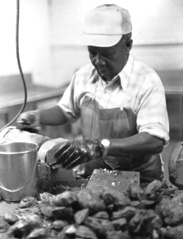
Throughout the decade, bags of three-quarter-inch seedlings have been fostered out to grow in oyster gardens.
In 1994, for example, Pleasure Cove Yacht & Beach Club on Podickery Point set out 10,000 spat (photo at right). Over the years, the ideas has spread. Last summer, Chesapeake Bay Foundation began recruiting oyster gardeners to further restoration.
"We're providing a way people can help the Bay, and they love it," says Bill Goldsborough, senior Foundation scientist.
The oysters are tended weekly through wintery Bay waters, nestled in floating beds made of coated wire mesh boxes suspended from a frame of PVC tubing.
A year later, if the crop succeeds, each bed produces 2,000 two-inch oysters to be replanted in Chesapeake Bay.
"Get hundreds of people on a given tributary over years, and you'll see a difference," says Goldsborough.
1998: Turning the Tide
From the Maryland Oyster Roundtable Action Plan, the Oyster Recover Partnership was born.
"In our first year, we decided on hands-on activities, providing labor to ensure that oysters got from tanks out to growing sites," says Partnership Director Robert Pfeiffer.
In its three-year history, the Partnership has planted millions of diesease-free oysters in the Severn, Patuxent and Choptank Rivers. Last year, working with University of Maryland's Horn Point Laboratory's expertise and larvae, the Partnership extended its plantings to Dorchester and Talbot Counties.
"In total last year, we handled about 22 million oysters,"
sa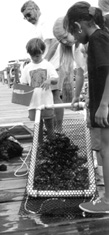 id Pfeiffer.
id Pfeiffer.
This summer, the Partnership wants both to do more and to "get the word out to the public."
Now, dear reader, that you've got the word, we invite you to take part. First, come to NBT's Birthday Bivalve Bash with money to bid on good times, good goods, good services to help plant more oysters. Next, join in the planting. We'll let you know when and where our oysters' time comes.
Finally, Pfeiffer promises "an actual accounting of where the money went and what it did. Those oysters will become a regular point of our monitoring,"
To learn more, visit the museums where Chesapeake Bay's oyster history is preserved:
Thanks to these museums and Bob Pfeiffer at the Oyster Recovery Partnership for information and many illustrations.
Reporting and other photos by Sandra Martin with Steve Armstrong, Carol Glover, Bob Hall, Alex Knoll and Bill Lambrecht.
| Back to Archives |
VolumeVI Number 17
April 30 - May 6, 1998
New Bay Times
| Homepage |